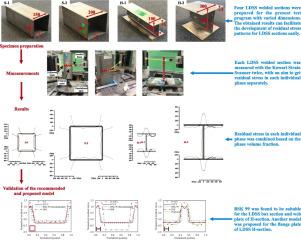Journal of Constructional Steel Research ( IF 4.0 ) Pub Date : 2021-08-04 , DOI: 10.1016/j.jcsr.2021.106883 Dongxu Li 1 , Anna Paradowska 1, 2 , Brian Uy 1 , Jia Wang 1 , Gwénaëlle Proust 1, 3 , Sina Kazemzadeh Azad 1 , Yerong Huang 1

|
Lean duplex stainless steel (LDSS) has been increasingly utilised in engineering applications due to its excellent durability, corrosion resistance, as well as superior structural and economic benefits. Moreover, compared to cold-form sections, welded members have significant structural advantages, and thus, have been widely used in many engineering practices. However, as one of the key factors affecting the performance of structural components, residual stresses of LDSS welded sections have not been sufficiently investigated. Therefore, square and H-shaped LDSS welded sections were considered in the present experimental programme. Accurate measurements of the tensile and compressive residual stresses were conducted through the non-destructive neutron diffraction method. As LDSS is a dual-phase material, neutron diffraction measurement was repeated twice for each specimen to obtain the individual phase residual stresses (ferrite-phase, α and austenite-phase, γ). Hardness analysis, as well as microstructural characterisation using optical microscopy and electron backscatter diffraction (EBSD) were thereafter performed to ascertain the volume fraction of each phase, based on which the residual stresses along the direction of interest were successfully converted. According to the obtained experimental results, the authors recommended analytical models for the LDSS fabricated square sections and proposed new models for the H-sections, through which the residual stress distributions for welded LDSS sections can be accurately predicted. In addition, the recommended/proposed analytical models for LDSS sections were further compared with their counterparts previously developed for high-strength steel (HSS) and ultra-high-strength steel (UHSS) welded sections.
中文翻译:

精益双相不锈钢焊接截面的残余应力测量
精益双相不锈钢 (LDSS) 由于其优异的耐用性、耐腐蚀性以及卓越的结构和经济效益,已越来越多地用于工程应用。此外,与冷弯型材相比,焊接构件具有显着的结构优势,因此在许多工程实践中得到了广泛的应用。然而,作为影响结构部件性能的关键因素之一,LDSS焊接截面的残余应力尚未得到充分研究。因此,在本实验方案中考虑了方形和 H 形 LDSS 焊接截面。拉伸和压缩残余应力的精确测量是通过无损中子衍射方法进行的。由于 LDSS 是一种双相材料,α和奥氏体相,γ)。此后进行硬度分析以及使用光学显微镜和电子背散射衍射 (EBSD) 的微观结构表征,以确定每个相的体积分数,基于此,成功转换了沿感兴趣方向的残余应力。根据获得的实验结果,作者为LDSS制造的方形截面推荐了解析模型,并为H形截面提出了新模型,通过这些模型可以准确预测焊接LDSS截面的残余应力分布。此外,对 LDSS 截面的推荐/提议分析模型与之前为高强度钢 (HSS) 和超高强度钢 (UHSS) 焊接截面开发的对应模型进行了进一步比较。











































 京公网安备 11010802027423号
京公网安备 11010802027423号